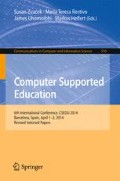Abstract
Current massively open online courses (MOOCs) are providing several technical challenges for educators. One of these challenges is automated generation of questions, along with the solutions, in order to deal with a large number of students. Geometry is an important part of the high school curriculum. Hence, in this paper, we have focused on the high school geometry domain. We have proposed a framework that combines a combinatorial approach, pattern matching and automated deduction to generate and solve geometry problems for high school mathematics. The system would help teachers to quickly generate large numbers of questions on a geometry topic and may also support the setting of standardized tests such as PSLE, GMAT and SAT.
Our novel methodology uses (i) a combinatorial approach for generating geometric figures from the user input, (ii) a pattern matching approach for generating questions, and (iii) automated deduction to generate new questions and solutions. By combining these methods, we are able to generate questions involving finding or proving relationships between geometric objects based on a specification of the geometry objects, concepts and theorems to be covered by the questions. We propose several algorithms to avoid generation of repeated questions and to avoid questions having redundant information, which increases the effectiveness of our system. We have tested our generated questions on an existing geometry question solving software JGEX, verifying the validity of the generated questions. A survey with the real users such as high school teachers and students on generated questions and solutions shows that our system is effective and useful.
Access this chapter
Tax calculation will be finalised at checkout
Purchases are for personal use only
References
Chou, S.C., Gao, X.S.: Handbook of Automated Reasoning. Elsevier and MIT Press, Cambridge (2001)
Chou, S.C., Gao, X.S., Zhang, J.Z.: A deductive database approach to automated geometry theorem proving and discovering. J. Autom. Reasoning 25(3), 219–246 (2000)
Chou, S.C., Gao, X.S., Zhang, J.Z.: Area method and automated reasoning in affine geometries (2011)
Coelho, H., Pereira, L.: Automated reasoning in geometry theorem proving with prolog. J. Autom. Reasoning 2(4), 329–390 (1986)
Frühwirth, T., Raiser, F. (eds.): Constraint Handling Rules: Compilation, Execution, and Analysis. Books On Demand, March 2011
Gao, X.S., Zhu, C.C., Huang, Y.: Building dynamic mathematical models with geometry expert, I. Geometric transformations, functions and plane curves. In: Proceedings of the Third Asian Technology Conference in Mathematics (1998)
Gao, X.-S., Lin, Q.: MMP/geometer – a software packagefor automated geometric reasoning. In: Winkler, F. (ed.) ADG 2002. LNCS (LNAI), vol. 2930, pp. 44–66. Springer, Heidelberg (2004)
Greeno, J.G., Magone, M.E., Chaiklin, S.: Theory of constructions and set in problem solving. Mem. Cogn. 7, 445–461 (1979)
Jiang, J., Zhang, J.: A review and prospect of readable machine proofs for geometry theorems. J. Syst. Sci. Complex. 25, 802–820 (2012)
McCharen, J.D., Overbeek, R.A., Wos, L.A.: Problems and experiments for and with automated theorem-proving programs. IEEE Trans. Comput. 25(8), 773–782 (1976)
Meikle, L.I., Fleuriot, J.D.: Formalizing Hilbert’s Grundlagen in Isabelle/Isar. In: Basin, D., Wolff, B. (eds.) TPHOLs 2003. LNCS, vol. 2758, pp. 319–334. Springer, Heidelberg (2003)
Narboux, J.: The area method: a recapitulation. J. Automat. Reasoning 48, 489–532 (2010)
National Council of Teachers of Mathematics: Curriculum and evaluation standards for school mathematics (1989)
Quaife, A.: Automated development of Tarski’s geometry. J. Automat. Reasoning 5, 97–118 (1989)
Singhal, R., Henz, M., McGee, K.: Automated generation of geometry questions for high school mathematics. In: Sixth International Conference on Computer Supported Education (2013) (Accepted for publication as full paper)
Schrijvers, T., Demoen, B.: The K.U. Leuven CHR system: implementation and application. In: First Workshop on Constraint Handling Rules (2004)
Vicknair, C., Macias, M.: A Comparison of a Graph Database and a Relational Database (2010)
Wilson, S., Fleuriot, J.D.: Combining dynamic geometry, automated geometry theorem proving and diagrammatic proofs. In: ETAPS Satellite Workshop on User Unterfaces for Theorem Provers (UITP) (2005)
Zhang, J.Z., Gao, X.S., Chou, S.C.: The geometric information search system by forward reasoning. Chin. J. Comput. 19(10), 721–727 (1996)
Author information
Authors and Affiliations
Corresponding author
Editor information
Editors and Affiliations
Rights and permissions
Copyright information
© 2015 Springer International Publishing Switzerland
About this paper
Cite this paper
Singhal, R., Henz, M. (2015). Geometry Question Generator: Question and Solution Generation, Validation and User Evaluation. In: Zvacek, S., Restivo, M., Uhomoibhi, J., Helfert, M. (eds) Computer Supported Education. CSEDU 2014. Communications in Computer and Information Science, vol 510. Springer, Cham. https://doi.org/10.1007/978-3-319-25768-6_13
Download citation
DOI: https://doi.org/10.1007/978-3-319-25768-6_13
Published:
Publisher Name: Springer, Cham
Print ISBN: 978-3-319-25767-9
Online ISBN: 978-3-319-25768-6
eBook Packages: Computer ScienceComputer Science (R0)

